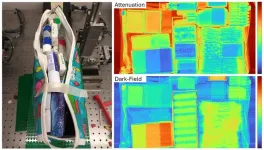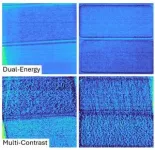(Press-News.org) WASHINGTON — Researchers have combined various x-ray imaging technologies to create multi-contrast images that can be used to detect threatening materials such as explosives in thousands of complicated scenarios. The new approach, which also leverages readily available machine learning procedures for materials classification, could be useful for security screening as well as applications in the life and physical sciences.
“This method is particularly well suited to discriminating objects with very similar elemental composition,” said research team leader Thomas Partridge from University College London in the UK. “It could be used in airport security or any inline scanning operation to examine materials flagged as suspicious by an initial fast scan such as a traditional x-ray system.”
In Optica, Optica Publishing Group’s journal for high-impact research, the researchers show that the new approach was highly effective in accurately detecting and identifying explosives in almost 4,000 scans of threatening and non-threatening materials hidden inside bags or obscured by various types of objects. They achieved a near-perfect recall rate of 99.68%, with just one false negative, from the threat-bearing cases.
“Although more work is needed, this approach could also prove useful for medical imaging,” said Partridge. “While traditional x-ray imaging struggles to separate healthy from diseased tissue, other studies have suggested that phase contrast imaging might be able to capture textures that could be used to distinguish healthy and benign tissues.”
Unlocking material secrets
The x-ray machines found in airports or medical facilities are based on x-ray attenuation, which images the reduction in intensity in x-rays after they pass through a material. The new technique creates multi-contrast images by combining conventional x-ray attenuation data at various x-ray energies with x-ray phase information, which consists of refraction and dark-field channels.
“Many explosives and common everyday items are composed of primarily carbon, hydrogen, nitrogen and oxygen, a similarity that makes them difficult to separate with x-ray attenuation alone,” said Partridge. “The additional channels offer significantly better enhancement of edges as well as textures and grains of materials, allowing the discrimination of objects with very similar elemental compositions.”
This work builds on previous efforts by the researchers to use multi-contrast x-ray phase enhanced imaging with machine learning approaches for threat detection with a smaller number of explosives and benign objects.
In the new experiment, they significantly scaled up the number of materials investigated and the number of imaging scenarios to better mimic real world situations. They also created a more effective scanning system with a resolution that could be changed by modifying the scanning speed and applied edge illumination phase contrast. Edge illumination involves placing masks before and after the sample to create the sub-pixel x-ray ‘beamlets’ needed to make the system sensitive to phase signals. One key advantage of this illumination approach is that it works with incoherent x-ray sources, widening its applicability.
Since the increased complexity of the imaging scenarios required more sophisticated protocols, the researchers applied machine learning with a hierarchical architecture that separated the cluttering objects before distinguishing material types. This made it possible to rapidly discern subtle differences in shapes and textures to distinguish materials based on key identifying features.
Detecting threats
To test the new technique, they used 19 threat materials and 56 non-threat materials, all at three thicknesses and obscured by a range of cluttering objects such as brushes, facewipes, socks and other items passengers would have in a carry-on bag. By using all the acquired contrast channels, the researchers demonstrated not just material discrimination but identification in some cases. Using deep learning to analyze the signals from the combination of x-ray contrasts provided very promising results, with just a single miss out of 313 threat cases.
The researchers say that translating this approach to a commercial setting would require improving the scanning speed through further optimization of the system. The robustness of material discrimination also needs to be tested on a larger set of data. One area of active study for the team is combining the method with 3D computed tomography scanning, which is being explored for security purposes because of its ability to provide detailed, three-dimensional images of objects.
Paper: T. Patridge, S.S. Shankar, I. Buchanan, P. Modregger, A. Astolfo, D. Bate, A. Olivo, “Multi-contrast x-ray identification of inhomogeneous materials and their discrimination through deep learning approaches,” 11, 6 (2024).
DOI: 10.1364/OPTICA.507049.
About Optica
Optica is an open-access journal dedicated to the rapid dissemination of high-impact peer-reviewed research across the entire spectrum of optics and photonics. Published monthly by Optica Publishing Group, the Journal provides a forum for pioneering research to be swiftly accessed by the international community, whether that research is theoretical or experimental, fundamental or applied. Optica maintains a distinguished editorial board of more than 60 associate editors from around the world and is overseen by Editor-in-Chief Prem Kumar, Northwestern University, USA. For more information, visit Optica.
About Optica Publishing Group
Optica Publishing Group is a division of Optica, Advancing Optics, and Photonics Worldwide. It publishes the largest collection of peer-reviewed content in optics and photonics, including 18 prestigious journals, the society’s flagship member magazine, and papers from more than 835 conferences, including 6,500+ associated videos. With over 400,000 journal articles, conference papers and videos to search, discover and access, Optica Publishing Group represents the full range of research in the field from around the globe.
END
Researchers detect hidden threats with advanced x-ray imaging
Multi-contrast x-ray imaging combined with machine learning effectively distinguishes threatening materials in thousands of complex scenarios
2024-05-23
ELSE PRESS RELEASES FROM THIS DATE:
Hypertension and kidney function after living kidney donation
2024-05-23
About The Study: In this cohort study of living kidney donors and nondonors with the same follow-up schedule, the risks of hypertension and albuminuria were not significantly different. After the initial drop in estimated glomerular filtration rate (eGFR) from nephrectomy, donors had a slower mean rate of eGFR decline than nondonors but were more likely to have an eGFR between 30 and 60 mL/min/1.73 m2 at least once in follow-up.
Corresponding Author: To contact the corresponding author, Amit X. Garg, M.D., Ph.D., email amit.garg@lhsc.on.ca.
To access the embargoed study: Visit our For The Media website ...
Kidney transplant outcomes from deceased donors who received dialysis
2024-05-23
About The Study: Compared with receiving a kidney from a deceased donor who did not undergo dialysis, receiving a kidney from a deceased donor who underwent dialysis prior to kidney donation was associated with a significantly higher incidence of delayed graft function, but no significant difference in graft failure or death at follow-up.
Corresponding Author: To contact the corresponding author, Chirag R. Parikh, M.D., Ph.D., email chirag.parikh@jhmi.edu.
To access the embargoed study: Visit our For The Media website at this link https://media.jamanetwork.com/
(doi:10.1001/jama.2024.8469)
Editor’s Note: Please see ...
Potentially habitable 'exo-Venus' with Earth-like temperature discovered
2024-05-23
Potentially habitable 'exo-Venus' with Earth-like temperature discovered
Royal Astronomical Society press release
RAS PR 24/12
Embargoed until 15:00 BST on Thursday 23 May 2024
Astronomers have made the rare and tantalising discovery of an Earth-like exoplanet 40 light-years away that may be just a little warmer than our own world.
The potentially-habitable planet, named Gliese 12 b, orbits its host star every 12.8 days, is comparable in size to Venus - so slightly smaller than ...
Earth twin or evil twin
2024-05-23
The discovery of a planet similar to Venus around a star in the neighborhood of the Solar System raises hopes that astronomers may someday unlock the secret to why life appeared on Earth.
The study of life in the Universe is difficult because we have only one example of a planet where life has been confirmed: Earth. It is difficult to say which characteristics of Earth are required for life to appear, and which are irrelevant. Until we find an “Earth twin” where the conditions for life also appeared, the best astronomers ...
Tracking down the genetic causes of lupus to personalize treatment
2024-05-23
Lupus is a lifelong, often painful and occasionally lethal autoimmune disease. Few treatments exist today beyond powerful steroids to knock down a patient's immune system — a therapy that has its own serious risks.
The good news is that new and promising treatments are in clinical trials. But the term lupus belies the fact that the disease has a variety of causes, which means that treatments will have to be highly personalized to guarantee that each patient is given the drug that targets the specific genetic mutation ...
New discoveries about the nature of light could improve methods for heating fusion plasma
2024-05-23
Both literally and figuratively, light pervades the world. It banishes darkness, conveys telecommunications signals between continents and makes visible the invisible, from faraway galaxies to the smallest bacterium. Light can also help heat the plasma within ring-shaped devices known as tokamaks as scientists worldwide strive to harness the fusion process to generate green electricity.
Now, scientists have made discoveries about light particles known as photons that could aid the quest for fusion ...
Lehigh University researchers explore innovative cable-based approach to aerial robotics
2024-05-23
When we think about drones, we tend to think about Amazon. But their potential is much greater, and arguably far more important, than dropping off a box of laundry pods by lunchtime (an idea that’s struggled to take off since Jeff Bezos floated it more than a decade ago).
Aerial robots could be a huge asset, saving time, money, and workers’ well-being, in industries like construction where humans often have to heft materials up multiple floors, says David Saldaña, an assistant professor of computer science and engineering. They could also deliver ...
Researcher charges ahead with new tech to power drones wirelessly
2024-05-23
Dr. Ifana Mahbub, assistant professor of electrical and computer engineering at The University of Texas at Dallas, has been awarded the Defense Advanced Research Projects Agency (DARPA) Director’s Fellowship to continue her research to develop wireless technology to recharge unmanned aerial vehicles (UAVs) in flight.
DARPA awards the fellowships to its Young Faculty Award recipients who demonstrate exceptional performance. Mahbub received a Young Faculty Award, which provided $500,000 over ...
Features of bloodstream infection among immunocompromised oncology patients presenting to the emergency department with fever
2024-05-23
Background and Aims
Oncology patients undergoing cancer treatment and experiencing episodes of fever are known to be at increased risk for invasive bacterial infection, including bloodstream infection. This study aimed to identify the incidence of bacteremia along with the bloodstream isolates for immunocompromised oncology patients referred to the emergency department (ED) due to fever.
Methods
Oncology patients with fever were referred to the ED according to a protocol previously reported. Virtually ...
How family economic insecurity can hurt child mental health
2024-05-23
COLUMBUS, Ohio – Economic difficulty caused by the COVID-19 pandemic led to a cascade of connected problems for some parents – resulting in mental health problems for their children, a new study suggests.
Researchers found that economic insecurity was linked to higher levels of depressive symptoms for parents, which was then associated with poorer relationship quality for the couples. That was linked with more harsh parenting and then to increased internalizing behaviors for their children.
“Pandemic-induced ...
LAST 30 PRESS RELEASES:
Blocking a key inflammatory pathway improves liver structure and vascular function in cirrhosis, study finds
Continuous spread: Raccoon roundworm detected in nine European countries
HKUST Engineering researchers developed a novel photodetector to enhance the performance of on-chip light monitoring
Strategic river sensors could have forewarned of Texas Camp flood disaster
Drone sampling of whale breath reveals first evidence of potentially deadly virus in Arctic
Roman soldiers defending Hadrian’s Wall infected by parasites, study finds
Pinochet’s prisoners were tormented with music but still found solace in it, a new book reveals
Fertility remains high in rural Tanzania despite access to family planning
AI-assisted device can improve autism care access
Kinetic careers
Uncovering how parasitic plants avoid attacking themselves to improve crop resistance
Nanoparticle vaccine strategy could protect against Ebola and other deadly filoviruses
Study finds brain care score can predict risk of stroke across racial groups
Key lung immune cells can intensify allergic reactions
Do hormones explain why women experience more gut pain?
New materials conduct ions in solids as easily as in liquids
Breakthrough of the Year: Renewable energy begins to eclipse fossil fuel-based sources
LLM use is reshaping scientific enterprise by increasing output, reducing quality and more
Introducing LightGen, a chip for ultra-fast, ultra-efficient generative AI
Astronomers see fireworks from violent collisions around nearby star
ACC/AHA issue new guideline on managing congenital heart disease in adults
Cosmic crash caught on camera
Is talented youth nurtured the wrong way? New study shows: top performers develop differently than assumed
Ants: An untapped resource in the development of antibiotics?
Archaeologists use AI to create prehistoric video game
Mitochondria migrate toward the cell membrane in response to high glucose levels
Tiny viral switch offers hope against drug-resistant bacteria
Most parents aware of early peanut introduction guidelines, but confused about details
HPV vaccine can protect against severe lesions of the vulva and vagina
Virtual care provision and emergency department use among children and youth
[Press-News.org] Researchers detect hidden threats with advanced x-ray imagingMulti-contrast x-ray imaging combined with machine learning effectively distinguishes threatening materials in thousands of complex scenarios







